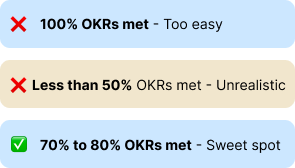
Introduction
OKRs (Objectives and Key Results) with performance goals are often mixed up. While both are important, they serve very different purposes. Confusing the two can lead to wasted effort, misaligned priorities, and missed opportunities.
This article breaks down the differences and provides a framework for managing OKRs effectively so that they become the true driver of your organization’s strategy execution.
Why the Distinction Matters
At first glance, OKRs and goals may look similar, both describe what you want to achieve. But the intent, time horizon, and impact are different.
Goals are directional, but OKRs drive measurable execution
- Goals are broad outcomes you want to achieve, like “Increase market share” or “Improve customer satisfaction.”
- OKRs take that ambition and turn it into a measurable execution system, “Objective: Become the market leader in mid-market SaaS. Key Result: Grow new ARR from $10M to $15M by Q4.”
The key difference? Goals set direction, while OKRs ensure the team actually gets there through measurable progress.
OKRs are not the same as KPIs either
Another common trap is to confuse OKRs with KPIs. KPIs measure business health, like churn rate or NPS. OKRs are change-oriented. They define what needs to improve or change to move the business forward. Read further about KPIs & OKRs here ↗️.
Why You Don’t Need to Achieve 100% of Your OKRs
One of the biggest mistakes in OKR adoption is treating them like performance targets that must be hit exactly. OKRs are meant to be ambitious. If you’re always hitting 100%, your OKRs are too easy. A good target pushes teams to stretch their capabilities, innovate, and rethink how work gets done. Missing an OKR isn’t failure, it’s data. Did the assumption prove wrong? Did market dynamics shift? Did the team uncover a more important opportunity? A missed OKR should spark insight, not punishment.

Time Horizons - Why OKRs Work Best in Short Cycles
Performance goals can span a year or more. But OKRs must be shorter. Why? Because performance goals are directional and they describe where you want to end up. OKRs on the other hand, are bets on advancing the strategy and such bets must be quick, nimble and must be adjusted every quarter.
Quarterly OKR Cycles
Quarterly cycles force agility. Every 90 days, you re-align around the strategy, adjust for new insights, and reset focus. This cadence ensures that teams don’t drift into working on things that no longer matter and prevents working on irrelevant OKRs out of just habit.
When to shorten or extend OKR cycles
Some functions, like Product may benefit from shorter OKRs (6–8 weeks). Others, like enterprise sales may need slightly longer cycles. The key is consistency in every OKR cycle. Each cycle should create a rhythm of planning, execution, and reflection.
Keeping OKRs Alive
Setting OKRs once a quarter isn’t enough. Without regular review, they become stale quickly. High-performing teams check progress against OKRs weekly or bi-weekly. These aren’t long meetings, a 15 minute checkpoint with a clear structure does the magic. The focus should be on what progress have we made? What’s blocked? and, what adjustments are needed?
Tools and rituals that maintain OKR visibility
OKRs should never live in a hidden spreadsheet. With Tesoract, they become visible across the company. Tesoract's OKRs come with a discussion thread dedicated to each key result, providing detailed context at a key result level while Tesoract's OKR dashboard provides a high level overview of all OKRs in a strategy.
The Distinction Does Matter
This is where many organizations stumble, treating OKRs like individual performance goals. Performance goals do matter, as they provide clarity to team members. Performance goals like “Close $2M in new deals” for a sales rep, or “Maintain 99.9% uptime” for an engineer. These ensure people do their jobs well. But they don’t always advance a strategy.
OKRs bridge daily work and strategy
Every OKR must tie directly to strategy. If your strategy is to expand into enterprise clients, your OKRs should reflect that, "new enterprise pipeline", "enterprise onboarding NPS", "enterprise case studies published" etc,. Unlike performance goals, OKRs are the connective tissue that ensures everyone’s work ladders up to the strategy.
Even with good intent, teams often fall into traps such as too many OKRs, confusing them with KPIs, or treating them as paperwork. We’ve written a full post on common mistakes in writing OKRs that dives deeper into this.
OKRs and performance goals are not the same. Performance goals ensure clarity and help guide individual performance, but OKRs drive strategic change. By,
- Embracing stretch targets,
- Working in short cycles,
- Keeping OKRs visible by using the right tools, regular check-ins, and
- Tying every OKR directly to strategy
you transform OKRs into a living system for strategy execution. Tesoract can help you bring focus, alignment, and clarity to your OKRs. Book a call to explore more.






.svg)
.svg)
